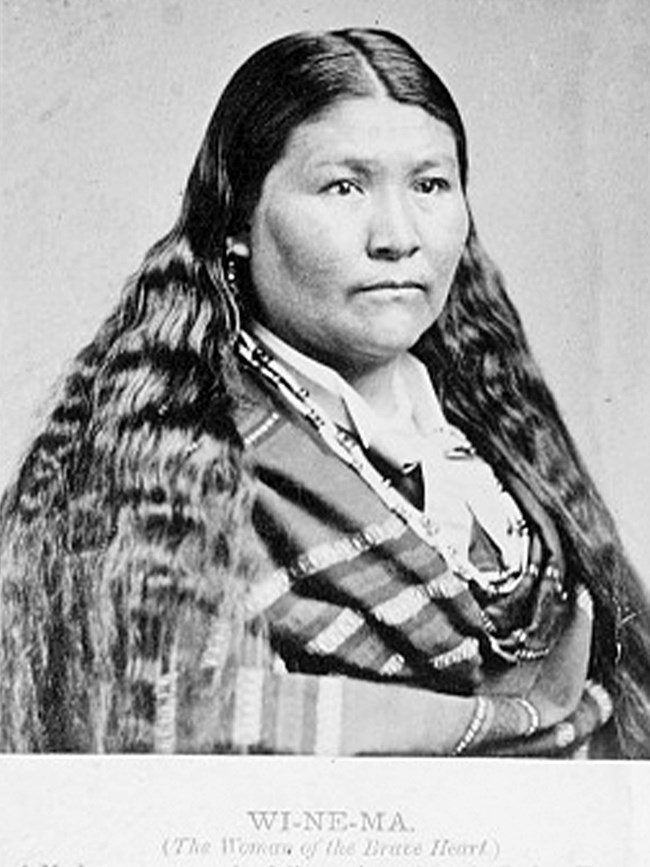Part of a series of articles titled Women's History in the Pacific West - California-Great Basin Collection.
Previous: Lucille Vinyard
Article

Courtest Natural Museum of Natural History, NAA Photo Lot 176 (BAE GN03051B)
Toby Riddle was a Modoc woman who served as a translator for the US Army during the Modoc War of 1872 to 1873, which took place in the ancestral homelands of the Modoc people, now part of Lava Beds National Monument. Riddle was a cousin to Kientpoos, a Modoc leader (also known by white settlers as Captain Jack), who was hanged, along with three other Modoc men, by the US Army after the war’s close. Riddle is known for her collaborative role in working with the United States government, including the Oregon Superintendent of Indian Affairs, Alfred B. Meacham.
Riddle was born in 1848 as Nanooktowa, a name that her great-great-granddaughter Debra Herrera translates as “strange child,” possibly a reference to some kind of uncommon behavior of her ancestor as a girl.1 In 1862, Nanooktowa began cohabitating with Frank Riddle, a white man from Kentucky, and they married soon after.2 A year later, while the couple was living on a ranch along Bogus Creek, Riddle gave birth to their only child, Jefferson Davis Riddle, who was also known amongst his Modoc family as Charka.3
The Modoc War broke out in 1872, after two previous attempts by the US government to relegate the Modoc to live on the Klamath reservation with the Klamath and Yahooskin band of the Paiutes with whom they had bad relations. The US Army attempted to forcibly remove Kientpoos and other Modoc from their settlement along the Lost River, where they had returned after leaving the Klamath reservation. The Modoc resisted removal and fled to the Lava Beds. Throughout that winter and into spring, the Modoc and white settlers, aided by the US military, attacked each other. The skirmishes resulted in the burning of Kientpoos’ village, the deaths of a Modoc woman and child and fourteen male settlers. In January 1873, a battle ensued when the US Army unsuccessfully attacked the Modoc in their well-defended position in Lava Beds. The Modoc won the battle.4 The US Army formed a Peace Commission in 1873, headed by Alfred B. Meacham, with the intent of negotiating with Kientpoos and the other Modoc.5
Due in part to her proficiency in English and the Penuitian language spoken by the Klamath Modoc, as well as her relation to Kientpoos, Frank and Toby Riddle were asked by Superintendent Meacham to work with him as translators and mediators on the US Peace Commission in February 1873.6 On April 11, Riddle warned the Peace Commission of an attack planned on the Peace Tent. The Commission failed to heed her warning.7 General Canby and Reverend Thomas were killed that day; however, Riddle may have prevented Meacham’s death once gunfire had already begun.8 For her role in translating and facilitating peace negotiations, Riddle was awarded a military pension by the United States government.
Soon after the war, Riddle adopted professional use of the name Winema. Meacham’s 1876 account of Riddle’s life notes her early use of Winema, suggesting a conscious reference to Joaquin Miller’s popular 1871 poem about an Indigenous woman named Winemma who sacrifices herself for a white hero.9 In Meacham’s story of Winema he presented her as “Pocahontas of the Modoc"10 – a woman who left her family and ancestral homeland, married a white man, served as a translator for the US Army, and who prevented his death. Riddle starred as Winema in Meacham’s popular staged tour, cementing this romanticized characterization of her life. Although the tour provided a source of income for all parties involved, it also became the source of intense homesickness and sorrow for Toby Riddle. Riddle eventually returned to the Klamath Basin. In 1920, she died from influenza six years prior to the dedication of the Lava Beds as a National Monument. As Modoc historian and former Lava Beds National Park Ranger Cheewa James has asserted, for many Modoc people the history of the Modoc War is a family story.11
This project was made possible in part by a grant from the National Park Foundation.
This project was conducted in Partnership with the University of California Davis History Department through the Californian Cooperative Ecosystem Studies Unit, CA# P20AC00946
Boyd Cothran, Remembering the Modoc War: Redemptive Violence and the Making of American Innocence, University of North Carolina Press, 2014.
Rebecca Bales, “Winema and the Modoc War: One Woman's Struggle for Peace,” Prologue Magazine 37.1 (Spring 2005). https://www.archives.gov/publications/prologue/2005/spring/winema.html.
National Park Service, “The Modocs,” park unigrid, Early-Modoc-FINAL.pdf (PDF, 98 KB).
National Park Service, “The Modoc Way, “ park unigrid, MODOC%20WAY.pdf (PDF, 274 KB).
1 “History Detectives: Modoc Basket,” History Detectives (PBS: Oregon Public Broadcasting, 2010).
2 Robert Aquinas McNally, The Modoc War: A Story of Genocide at the Dawn of America's Gilded Age (Lincoln : University of Nebraska Press, 2017),155.
3 McNally, The Modoc War 155.
4 Lava Beds National Monu,ment, “A Brief History of the Modoc War,” NPS.gov (National Parks Service), accessed March 16, 2021, https://www.nps.gov/labe/planyourvisit/upload/MODOC%20WAR.pdf, 1.
5 Cothran, Remembering the Modoc War, 38, 39.
6 Cothran, Remembering the Modoc War, 68; McNally, The Modoc War 156.
7 McNally, The Modoc War 195.
8 Cothran, Remembering the Modoc War, 84.
9 Cothran, Remembering the Modoc War,101.
10 Alfred Meacham, Wi-ne-ma (The Woman-Chief) and Her People (Hartford, CT: American Publishing Company, 1876).
11 Cothran, Remembering the Modoc War, 2, 93, 101, 108.
Part of a series of articles titled Women's History in the Pacific West - California-Great Basin Collection.
Previous: Lucille Vinyard
Last updated: March 29, 2022